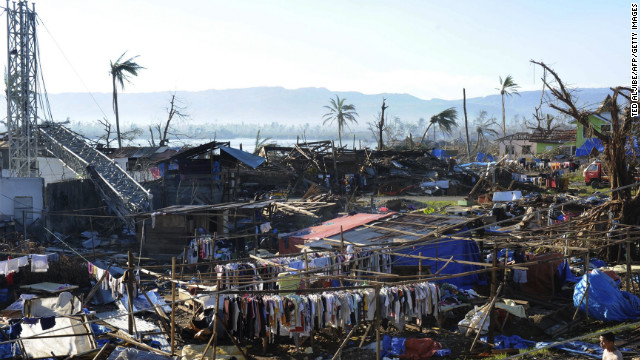Nearly 900 people are
still unaccounted for in the aftermath of Typhoon Bopha, the strongest
and deadliest storm to hit the Philippines this year, according to the
country's emergency management agency.
The numbers of dead and
missing have risen drastically during the past several days as
government officials have gathered information from isolated areas where
the scale of the devastation was previously unknown.
Both of the grim totals
are likely to increase further this week, said Benito Ramos, head of the
National Disaster Risk Reduction and Management Council, the emergency
agency. Search and rescue efforts are continuing, he said, despite the
declining chances of finding people alive.
"We are still hoping
against hope that there are still survivors," he said by telephone,
adding that some of the hundreds of fishermen reported missing after the
storm could yet be found sheltering on small islands out at sea.

If only a few of those
missing are found alive, Bopha could eventually prove more deadly than
Tropical Storm Washi, which killed 1,268 people a year ago. But its toll
would still remain far below that of Tropical Storm Thelma, the
country's most lethal storm on record that left more than 5,000 people
dead in 1991.
The worst of the death
and destruction from Bopha took place on the southern island of
Mindanao, where the storm hit first and hardest with gusts as strong as
220 kph (138 mph). In the provinces of Compostela Valley and Davao
Oriental, the heavy rain set off flash floods and landslides that engulfed whole neighborhoods, and the winds ripped apart fragile houses.
Many residents were
unprepared or unaware of the typhoon's threat to the region, which
rarely experiences tropical cyclones of such magnitude. Bopha, known
locally as Pablo, was the most powerful typhoon to hit Mindanao in
decades.
Compostela Valley and
Davao Oriental account for the vast majority of the 714 people killed
and for most of the 890 still missing nationwide. A week after the
typhoon struck, survivors there are facing many obstacles to rebuilding
their lives.
Hundreds of thousands of
people are living in evacuation centers or relying on the government
for other kinds of assistance, according to the national emergency
agency.
And hundreds more, who
have not been able to find refuge in the centers, line the roads of
Compostela Valley, said Arlo Ramos, a relief worker in the region for
World Vision, a humanitarian group.
"During the daytime,
they stand along the side of the road, they ask for food," he said. At
night, they sleep in small, makeshift shelters cobbled together out of
bits of wood and canvas scavenged from the debris, he added.
In New Bataan, the town
at the heart of the devastation, dead bodies are still being found and
lined up in an open space in front of an evacuation center, according to
Arlo Ramos.
When aid workers or
government officials arrive in the town, he said, residents crowd around
them, hoping to get the food or water they desperately need, he said.
The region's prospects
for longer term recovery are also bleak, since the storm laid waste to a
great deal of the agricultural land on which many residents rely for
their livelihood.
"Farming communities have been the worst hit and it could take many years for them to fully recover," said Paul del Rosario, the humanitarian program coordinator for the charity Oxfam.
The United Nations has announced a global appeal
to try to raise $65 million to help those affected by the storm. And
Philippine President Benigno Aquino III, who visited New Bataan and
other severely affected areas last week, has declared a state of
national calamity, which releases emergency funds and puts price
controls on basic goods.
Finger pointing has also
begun among officials over the reasons why so many people lost their
lives. Local authorities have been criticized for not anticipating the
scale of the destruction.
And a member of Aquino's
government, Environment Secretary Ramon Paje, has said illegal logging
and mining contributed to the landslides and flash floods on Mindanao.
Paje has implemented measures aimed at clamping down on logging in Philippine forests.
"Several quarters are
criticizing the declaration of a total log ban but look at what
happened," he said last week, referring to the devastation on Mindanao, according to CNN affiliate ABS-CBN. "It is now proving that we really must stop timber harvesting, especially in our natural forests."
No comments:
Post a Comment